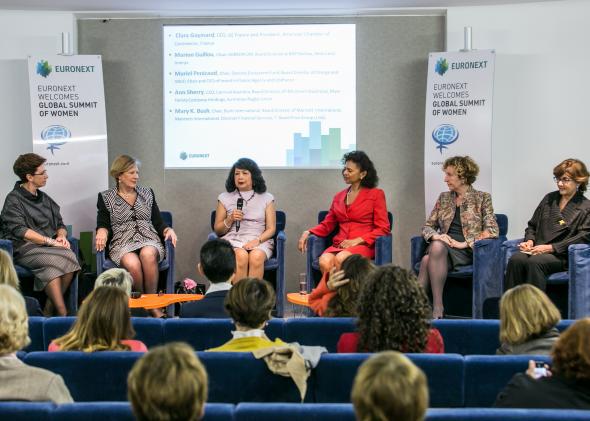Today, Québécois commentator Marie-Andrée Paquet tweeted a familiar image: a photograph of six white male CEOs holding court on a conference stage. “Une image vaut mille mots, disent-ils,” she wrote: A picture is worth a thousand words. In this case, most of those words are real mad. The image has since been retweeted more than 500 times, collecting comments like “How to man the decks at a summit for women,” “What were they thinking?” and “Les Hommesplaining.”
The photo was snapped at the 2014 Global Summit of Women, which brought more than 1,000 women from more than 80 countries together to discuss how to increase women’s economic opportunities all over the world. A few good men agreed to participate, too. On a panel called “Redefining the Marketplace: The Business Case for Gender Equality,” male CEOs in the fields of banking, energy, and law took to the stage to discuss how recruiting and fostering female talent can drive a company’s financial success. One panelist, Gianmarco Monsellato, the CEO of French corporate law firm TAJ, has made it his mission to recruit powerful men into the fight for gender equality. Over the past decade, he’s helped achieve gender parity at TAJ at all levels of leadership and vaulted the company into the top tier of French firms. Monsellato believes that endorsing Lean In–style correctives, which focus on female employees’ own behavior at the expense of male leaders’ actions, and diversity initiatives, which ask women talk among themselves and present their findings to male leadership, will never succeed until powerful men are pressured to take up the cause themselves. In other words, this all-male panel is great.
Another panel at the summit recruited both men and women to talk about a company’s responsibilities toward achieving employee work-life balance, and it sure is nice to watch men and women talking about issues that affect them both. I’ve sat on too many all-female panels, talking about “women’s” issues that really affect everyone, wishing there were men involved who could help push the conversation outside of the ladysphere. But it’s positively radical to bring a slate of male CEOs onstage to publicly account for the gender breakdowns of the companies they run. As summit President Irene Natividad put it: “Gender equity can accelerate if more men are engaged in the effort.”
By the way, a typical panel at the summit looked like this:

Global Summit of Women
What a bunch of misogynistic jerks.
The outrage that swiftly coalesced around the photo is typical of a kind of quick-take feminism that has just enough time to count the bodies and plug them into the reality of male global domination, but not enough space to actually understand the specifics of the example, where the dynamics of gender are a lot more complicated than the numbers suggest. (This is not specifically a failure of feminism—no worldview is immune.) Last week, we got a peek at this knee-jerk response’s opposite extreme when the New Republic published a bizarre feminist reaction to the news that Chelsea Clinton raked in $600,000 a year as an occasional correspondent for ABC News, headlined “Chelsea Clinton $600,000 a Year at NBC. That Upset a Lot of Male Journalists.”
“Her impressive paycheck, deserved or not, is a step toward balancing the scale,” Amy Weiss-Meyer wrote, citing the poor representation and pay of women in journalism and calling out the “male journalists” who criticized Clinton’s payday. By focusing solely on Clinton’s gender, Weiss-Meyer—who is an intern at a publication that does not pay its editorial interns—ends up just supporting nepotism, a system that will actually disenfranchise most women. Meanwhile, female journalists who shared the same view as their male counterparts became totally invisible.
This perspective sees the fight for gender equality as one that necessarily pits men and women against one another: women good, men bad. But as Monsellato’s hard, dedicated work shows, gender equality benefits everyone, and so do the men working for it.
